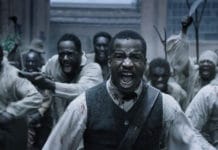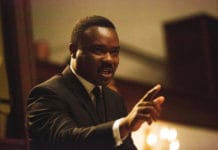Review by Wanda Sabir
Africans playing African Americans? Now what will Hollywood think of next? I guess on the plus side having continental Africans in a film with African Americans could draw another audience to such a theme as slavery, an issue I do not hear Africans outside of the Western Hemisphere making much fuss over.

In Pemba, the second largest island in the Zanzibar Archipelago, there are other ruins, a slave cave located on the private beach of a resort – yes it is crazy – fat white tourists sunning themselves a few hundred feet from a place where our ancestors were chained. There is a metal marker with this information engraved there. Saidi knew the spot from grade school and took me there; we got in because he knew the manager. They’d gone to tourism school together.
As a descendent I have been the lone Black American visitor to such places many times and find myself overlooked or passed over for the descendents of the slave owners and profiteers. The bitterness in my tone is intentional, so to see Africans profiting once again along with the descendents of the slave owners on the back of freed, enslaved and then freed Solomon Northup, the film makes me pause and reflect.
Perhaps it is the Maafa speaking here, which I have not recovered from … yet.
“12 Years a Slave” affected me differently than Quentin Tarantino’s “Django,” which in its caricature style held me spellbound or suspended in a place of imaginative wonder – the Black man was going to win and get the girl too in the end. In “Django,” the enemy was clearly identified and the dynamics crafted with such attention to polarities – mostly black and white, it was easy to root for the good guys and smile when the bad guys were crucified.
The situation is muddied and mixed up in “12 Years.” The bad guys are often painted with a bit of humanity that doesn’t change the outcome for poor Northup, yet presents a more nuanced portrait of the slave trade as an economic system that many white plantation owners used to assuage debt. There is even a white man who picks cotton along with the enslaved Africans – his story to Northup is that the slave system negatively affects both the captives and their guards. He survived by staying in an alcohol induced stupor, so hateful was his occupation – the man was a liar, a good one at that, Northup learned the hard way.

Continental Africans in Africa do not mention slavery enough and marvel that this is what we do here in the Pan African Diaspora. We also remember our ancestors. Traditionally folks might be getting away from this, but here we haven’t. Kids don’t study the European slave system in the public schools in the parts of Africa I visited.
These schools use colonial standards to matriculate and pass students on, so why would such a system speak the truth about its initiation and participation for 500 years in the worst crime against humanity this world has ever known?
The lead actor Chiwetel Ejiofor as Solomon Northup loves his family, wife and children. One of his children is Margaret Northup, portrayed by Oscar nominated award winning actress Quvenzhané Wallis, who starred in “Beasts of the Southern Wild.” Dwight Henry, the New Orleans actor who plays her father in “Beasts,” is in this film as well, as Uncle Abram.
I spoke to Mr. Henry about “Beasts.” He told me then that he was working on an important film. It was the year Hurricane Isaac hit on the anniversary of its predecessor, Katrina, Aug. 29, 2012. This is the film he spoke of. The film is shot in Louisiana on location at four historic antebellum plantations: Felicity, Magnolia Plantation, Bocage and Destrehan – one of these close to the actual plantation in which Northup was held.
Once kidnapped from his home in Saratoga Springs, New York, in 1841, sold and then sold again, one could see in Northup’s face the trauma and disbelief that he might die enslaved, lost to his family forever. Other characters in the story are a mother whose slavemaster’s daughter sold her away because she disliked her father’s favor on her and the child he’d begotten with her. This mother’s children are both sold away from her separately and she never gets over her grief, which her new owner’s wife dismisses with, “Oh, you’ll be fine in a couple of days,” as if she will soon forget her children. Animals do not forget their young either and mourn them when taken away.
The 12 years tick by slowly as Northup in his new guise and new name tries to adapt while holding onto the notion that somehow he will be free one day. He tries to get along, keep his intelligence in check and suffer the brutality to himself and others, but on more than one occasion he talks too much and acts on an injustice to himself or another – more often than not an enslaved woman.
He is sold from a gentile plantation with slave owner William Ford (Benedict Cumberbatch). Its owner keeps Northup, now Platt, from being hanged, yet cannot keep him safe – plus he has a debt to repay, so Northup/Platt is sold to a confirmed slave maker, Edwin Epps (Michael Fassbender), a drunken rapist whose superiority is grounded in his terrorist acts against other human beings, sanctioned by his belief in God’s appointment of white men over Black.

He also learns that white men are not to be trusted, especially Southern white men, but somehow he doesn’t lose his belief in justice and in human decency and that he will find someone to tell his story back home to friends who can come save him. Somehow, his spirit refuses to become broken.
Perhaps it’s hard to believe in something one doesn’t know exists, but Northup has been free, so he can believe with certainty in something different. It is not his imagination. He is like a man at sea who can see land ahead.
This film puts a lot of Black folks on the payroll, starting with Black American screen writer John Ridley (“Red Tails,” “Undercover Brother,” “Three Kings”) the Black British screenwriter and director, Steve McQueen (“Bear,” “Western Deep,” “Exodus,” “Hunger,” “Shame”). Known for his beautiful cinematography, McQueen’s screenplay eloquently speaks to the inhumanity of this economic system, its lessons not considered until black was the new white and the former owners wanted to make a deal in lieu of the power shift.
One of the stories within the story is that of Patsey (Lupita Nyong’o) as a young girl, barely an adolescent, whom Edwin Epps sexually abuses. She picks cotton by day – 500 pounds, more than any man, and gets raped at night. We see her playing with dolls in one scene and then raped in the next. The dolls don’t return, just scenes of abuse until pushed to the very edge, her owner who thinks he is being punished for his sins by god beats her until the skin falls from her back to the delight of his wife.
Alfre Woodard’s character, Mistress Harriett Shaw, works the system. Favored by her master, she is served rather than servant. She tries to school the younger girl, but Patsey’s owner is in a beastial (archaic spelling intentional) category that defies comparison. When Northup finally leaves, like all the others, he gives his former companions a backward wave.

How did he come to be free in the first place, he and his wife and family? Other loose ends in the film have to do with the Native Americans the enslaved Northup and other men encounter on a logging exposition – I thought he was going to escape and go into hiding.
Such are the nuances of this story. What is different about this Hollywood production, based on Northup’s memoir by the same title, and others I have seen in the past is the acknowledged participation or inclusion of Southern white women plantation owners, the wives of these brutal men and how these women were not innocent bystanders, rather active participants in the suffering of enslaved Black people.
Feigned compassion, nonetheless, equally capable of bearing the lash, is something Northup learned quickly. That callousness was not limited to white men, rather women too were active participants and so were their children, especially the girls, who grew into women who often resented half-Black siblings. It was a sick and brutal cycle of heinousness which made all hands in the pot filthy.
“Twelve Years” moved slowly and by the time Northup’s ordeal ends we are thankful yet exhausted. I saw the film alone. I think it’s the kind of journey one should invite a companion on. For more background information about the film and actors, visit http://en.wikipedia.org/wiki/12_Years_a_Slave_%28film%29.
Bay View Arts Editor Wanda Sabir can be reached at wsab1@aol.com. Visit her website at www.wandaspicks.com throughout the month for updates to Wanda’s Picks, her blog, photos and Wanda’s Picks Radio. Her shows are streamed live Wednesdays at 6-7 a.m. and Fridays at 8-10 a.m., can be heard by phone at (347) 237-4610 and are archived on the Afrikan Sistahs’ Media Network.

 Store
Store











